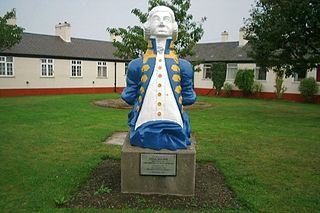Related Research Articles
Five ships of the Royal Navy have borne the name HMS Hercules, or HMS Hercule, after the Greek and Roman hero Hercules. Another was launched, but never served in the Navy:
Seven ships of the Royal Navy have been named HMS Cornwall after the Duchy of Cornwall. Cornwall's motto is onen hag oll , unus et omnes , one and all - English).
Sixteen ships of the Royal Navy have been named HMS Mermaid after the mermaid:
Eight ships of the Royal Navy have borne the name HMS Northumberland after the English county of Northumberland, or the Dukedom of Northumberland. Another was planned but later cancelled:
Eighteen ships of the Royal Navy have borne the name HMS Eagle, after the eagle.

HMS Cornwall was a 74-gun third-rate Vengeur-class ship of the line built for the Royal Navy in the 1810s. She spent most of her service in reserve and was converted into a reformatory and a school ship in her later years. The ship was broken up in 1875.
Nine ships of the Royal Navy have borne the name HMS Diana after the figure from Roman mythology, whilst another was planned but later cancelled:

HMS Boscawan was a 70-gun third rate ship of the line of the Royal Navy, launched on 3 April 1844 at Woolwich Dockyard. She was originally ordered and begun as a 74-gun ship, but an Admiralty order dated 3 March 1834 required that she be reworked to Sir William Symonds' design. She was named for Admiral Edward Boscawen.
Five ships and a shore establishment of the Royal Navy have borne the name HMS Cambridge, after the English town of Cambridge or after one of the Dukes of Cambridge:

HMS Wellesley was a 74-gun third rate, named after the Duke of Wellington, and launched in 1815. She captured Karachi for the British, and participated in the First Opium War, which resulted in Britain gaining control of Hong Kong. Thereafter she served primarily as a training ship before gaining the distinction of being the last British ship of the line to be sunk by enemy action and the only one to have been sunk by an air-raid.
Two ships and a training establishment of the Royal Navy have borne the name HMS Vernon, possibly after Admiral Edward Vernon:
Nine ships and a base of the Royal Navy have borne the name HMS Curlew after the bird, the curlew:
Eight ships of the Royal Navy have borne the name HMS Siren, Syren or Sirene, after the Sirens of Greek mythology:
Seven ships of the Royal Navy have been named HMS Melpomene after the Muse of Tragedy in ancient Greek mythology.
Eight ships of the Royal Navy have borne the name HMS Rattler:

HMS Ganges was a training ship and later stone frigate of the Royal Navy. She was established as a boys' training establishment in 1865, and was based aboard a number of hulks before moving ashore. She was based alternately in Falmouth, Harwich and Shotley. She remained in service at RNTE Shotley until October 1976.
Thirty-nine vessels of the Royal Navy and its predecessors have borne the name Swallow, as has one dockyard craft, one naval vessel of the British East India Company, and at least two revenue cutters, all after the bird, the Swallow:

The Wellesley Nautical School was a naval training school first located on the Tyne, and later removed to Blyth
Five ships of the Royal Navy have carried the name HMS Handy:
Six ships of the Royal Navy have borne the name HMS Ant:
References
- Colledge, J. J.; Warlow, Ben (2006) [1969]. Ships of the Royal Navy: The Complete Record of all Fighting Ships of the Royal Navy (Rev. ed.). London: Chatham Publishing. ISBN 978-1-86176-281-8.